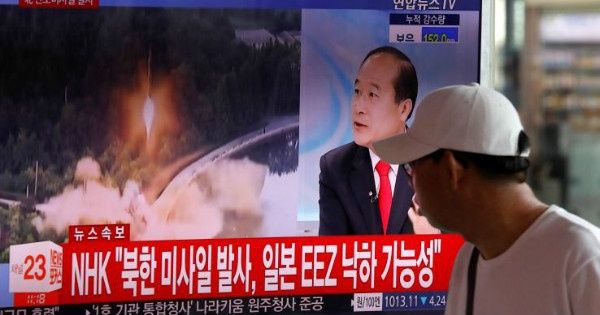On Tuesday, South Korean and U.S. officials confirmed that North Korea had test-launched an intermediate-range ballistic missile off its eastern coast.
RELATED:
South Korea Orders Probe into Extra, Undisclosed US THAAD Missile Launchers
According to the South Korean military and Japanese Government, the missile traveled 930 kilometers or 580 miles before landing in Japan's Exclusive Economic Zone, which South Korea and Japanese officials said was a violation of United Nations resolutions.
The U.S. Pacific Command said it detected and tracked the "single launch of a land-based, intermediate range ballistic missile" for 37 minutes near an airfield in Panghyon, about 100km or 60 miles northwest of Pyongyang.
South Korean President Moon Jae-in said the military was analyzing the missile, which could possibly have been an intercontinental ballistic missile, otherwise known as an ICBM-class rocket. The North has been developing a nuclear-tipped ICBM capable of hitting the United States.
North Korea has conducted four missile tests since South Korean President Moon Jae-in took office in May.

Analysts believe North Korea is only years away from having a nuclear-tipped ICBM.
North Korea, known as the Democratic People's Republic of Korea, has maintained that its program is a necessary deterrent against "aggression" from South Korea and the United States, who remain officially at war with the country.
Co-director of the Global Security Program at the US-based Union of Concerned Scientists, David Wright, said the assessments of the flight time and distance suggest the missile might have been launched on a “very highly lofted” trajectory of more than 2,800km.
“That range would not be enough to reach the lower 48 states or the large islands of Hawaii, but would allow it to reach all of Alaska,” he said.
In response to the launch, U.S. President Donald Trump wrote on Twitter:
North Korea has just launched another missile. Does this guy have anything better to do with his life? Hard to believe that South Korea.....
— Donald J. Trump (@realDonaldTrump) July 4, 2017
....and Japan will put up with this much longer. Perhaps China will put a heavy move on North Korea and end this nonsense once and for all!
— Donald J. Trump (@realDonaldTrump) July 4, 2017
On Tuesday, Japan's Prime Minister Shinzo Abe urged the presidents of China and Russia to play more constructive roles to stop Pyongyang's arms program.
“Leaders of the world will gather at the G20 meeting. I would like to strongly call for solidarity of the international community on the North Korean issue,” Abe told reporters.
Japan said on Monday the United States, South Korea and Japan will have a trilateral summit on North Korea at the G20.
South Korea and the DPRK were separated as states in the fallout of World War II when the occupying U.S. forces pressured the Soviet Union to cede control below the 38th parallel. To prevent the peninsula from falling to leftist forces, the South was put under U.S. control and consolidated as a separate republic.
A brutal conflict to reunify the peninsula ensued and U.S.-backed forces have remained officially at war with the DPRK since an armistice was signed on July 27, 1953.